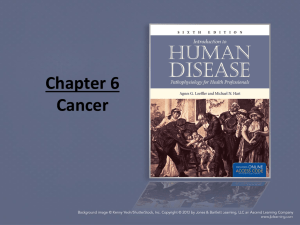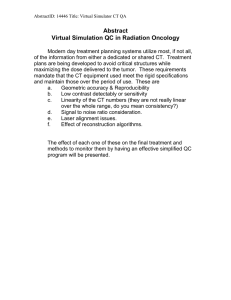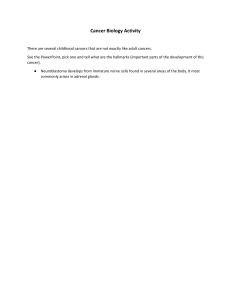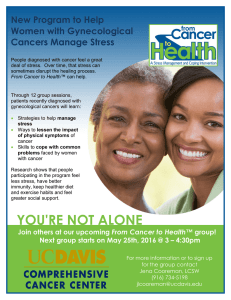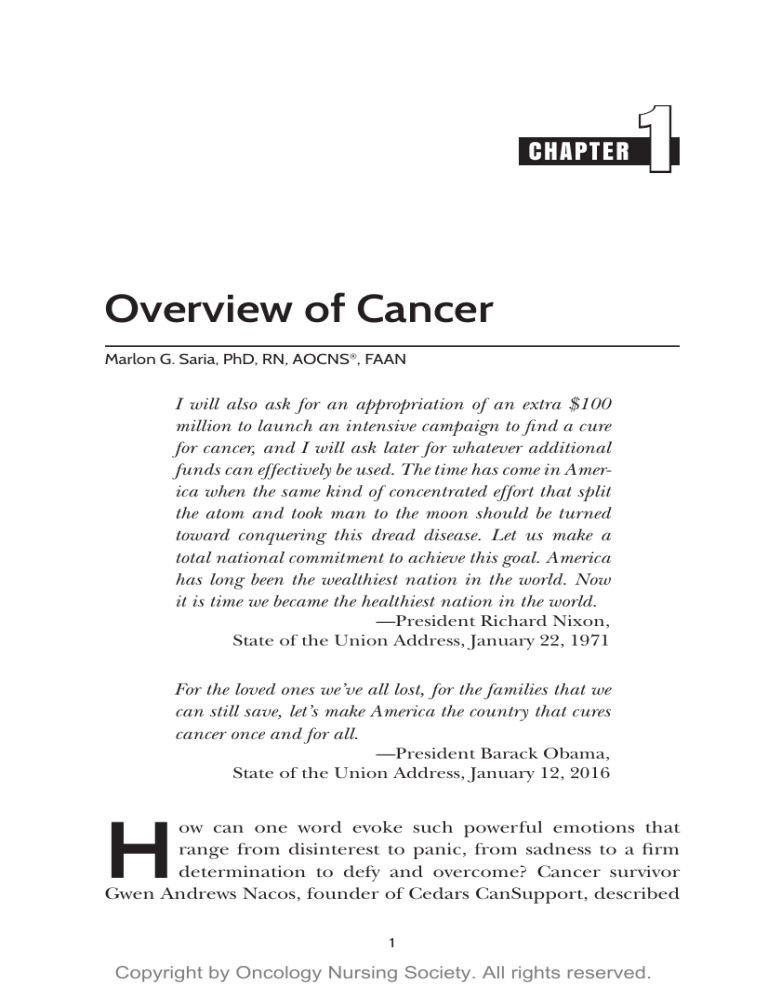
CHAPTER 1 Overview of Cancer Marlon G. Saria, PhD, RN, AOCNS®, FAAN I will also ask for an appropriation of an extra $100 million to launch an intensive campaign to find a cure for cancer, and I will ask later for whatever additional funds can effectively be used. The time has come in America when the same kind of concentrated effort that split the atom and took man to the moon should be turned toward conquering this dread disease. Let us make a total national commitment to achieve this goal. America has long been the wealthiest nation in the world. Now it is time we became the healthiest nation in the world. —President Richard Nixon, State of the Union Address, January 22, 1971 For the loved ones we’ve all lost, for the families that we can still save, let’s make America the country that cures cancer once and for all. —President Barack Obama, State of the Union Address, January 12, 2016 H ow can one word evoke such powerful emotions that range from disinterest to panic, from sadness to a firm determination to defy and overcome? Cancer survivor Gwen Andrews Nacos, founder of Cedars CanSupport, described 1 Copyright by Oncology Nursing Society. All rights reserved. 2 YOUR GUIDE TO CANCER PREVENTION the far-reaching impact of cancer when she said, “Cancer is not just a diagnosis. It becomes a way of life. When a person is diagnosed with cancer, the whole family gets cancer.” Many factors can increase the chances of cancer showing up uninvited at our front doors. Some of these factors we can’t do anything about— called nonmodifiable risk factors—while other factors we can change to lessen our risk of developing cancer. To combat the disease, cancer care is a threefold strategy: prevent cancer cases that can be prevented, cure all that can be cured, and manage the symptoms when a cure is not possible. Although cancer is still the second leading cause of death in the United States, progress in cancer research is improving survival. Today, more people with cancer are living at least five years after a diagnosis than in the 1970s. It was not until 1937, when President Franklin Delano Roosevelt launched the National Cancer Institute (NCI), that we started to build the foundation of our knowledge on the causes and treatments of cancer. Surgery and radiation therapy were being used in the treatment of cancer even before the creation of NCI, yet their success was limited to individual cases. We got our first glimpse of improved outcomes for populations in 1943 when the Pap test led to dramatic declines in cervical cancer deaths and reduction in U.S. cervical cancer rates by 70%. FACT OR FICTION: Cancer is a recent disease caused by our Western customs. Fiction. Cancer is not a disease of the modern world. It has been described in ancient texts as early as 3000 BC, and evidence of the disease has been found in fossilized bone tumors. In cancer treatment, the role of chemotherapy gained wide popularity in 1947 through the landmark case of a four-year-old girl with leukemia, the first known response of pediatric leukemia to a chemotherapy drug. It would be another two years before the Copyright by Oncology Nursing Society. All rights reserved. Chapter 1. Overview of Cancer 3 U.S. Food and Drug Administration approved the first chemotherapy drug for the treatment of cancer, nitrogen mustard. Like its wide array of treatments, cancer is a broad term often used to describe a large group of diseases defined by uncontrolled cell growth and division. It is important to emphasize that cancer is not one but many individual diseases that share a few key characteristics yet are distinct from each other. The following characteristics define cancer: • Uncontrolled proliferation—Cancer cells can grow out of control and form new tissue. • Abnormal differentiation—Cancer cells do not mature normally; therefore, they are not able to carry out their functions. • Loss of apoptosis—Cancer cells do not follow the typical cell cycle that leads to programmed cell death. • Loss of contact inhibition—Cancer cells ignore signals to stop dividing, and they do not die off to keep the number of cells constant. • Loss of cohesiveness and adhesiveness—Cancer cells can break away from the mass of cells, circulate through blood and lymphatic vessels, and spread to distant sites. • Impaired cellular communication—Cancer cells do not wait for signals from the body to form new tissue. • Tumor markers—Cancer cells can express (or overexpress) proteins, called antigens, on the cell surface, which makes them different from normal, healthy cells. It only takes one cell to transform (or mutate) and grow out of control for cancer to develop. This continued cell division leads to the growth of solid lumps in any part of the body—in any of the organs or tissues in the body (solid cancers) or an increase in any of the components of the blood cells (hematologic or blood cancers). Cancer can affect people of any age but occurs more often in older people, most likely from cumulative exposure to carcinogens, agents that are known to increase cancer risk. Cancer comes from our own cells; however, our chances of being affected by the disease can be linked to factors that come from both within and outside of our bodies. Risks can be driven by genetic predisposi- Copyright by Oncology Nursing Society. All rights reserved. 4 YOUR GUIDE TO CANCER PREVENTION tion or environmental and lifestyle factors. For most people who develop cancer, mutations happen at random (known as sporadic mutation); however, a small percentage of cancers will occur in individuals with an inherited mutation (referred to as hereditary cancer). How Cancer Develops Carcinogenesis or oncogenesis is the process by which normal cells transform into cancerous, or malignant, cells. Development of cancer is a complex process that, despite decades of research, we still do not completely understand. One of the most common explanations is that no single event directly leads to cancer occurring. According to multiple sources, a series of processes cause normal cells to change into malignant cells. Most healthy cells follow an internal clock, what is commonly referred to as the cell cycle, meaning they go through stages in life. The cell cycle begins when a single cell divides into two daughter cells. The progression of the cell cycle is regulated by signals from outside and within the cells. Interrupting or altering these signals can lead to changes within the cells. The three-stage theory of carcinogenesis is one of the most common explanations for the development of cancer. This theory divides cancer development into three stages: initiation, promotion, and progression. The theory is largely used for teaching purposes, as it is limited by the lack of biologic markers that define each of the stages. Initiation Initiation, the first stage, is when initial cell mutation occurs. It may involve one or more cellular changes that are either spontaneous or started by exposure to a carcinogen. These changes create a potential for the affected cell and its daughter cells to develop into a cancer cell. A disruption in the cell development cycle can be caused by a response to the activation of cellular genes known as oncogenes, the portion of deoxyribonucleic acid (DNA) that regulates normal cell growth and repair. Inactivation, Copyright by Oncology Nursing Society. All rights reserved. Chapter 1. Overview of Cancer 5 on the other hand, is the process whereby cellular genes known as tumor suppressor genes alter the normal cell cycle. Tumor suppressor genes are the components of DNA that stop, inhibit, or suppress cell division. Mutations in oncogenes and tumor suppressor genes allow cells to grow beyond normal body needs. The new cell clones that arise from the cellular changes typically have a selective and reproductive advantage over the original cells. The new cells exhibit uncontrolled division and loss of what is called apoptosis, or programmed cell death. Apoptotic genes are the components of DNA that control cell death. Mutations in apoptotic genes allow cancer cells to evade cell death. FACT OR FICTION: Cancer cells can live forever. Fact. Scientists have found a way to keep cancer cells immortal. HeLa cells are an “immortal cell line” used widely in cancer laboratories around the world. Considered the oldest human cancer cell line, the first HeLa cells were taken from the cervix of patient Henrietta Lacks on February 8, 1951. The cultured offspring cells have since been used in many scientific efforts, including cancer therapies, AIDS treatment, genetic mapping, and vaccine development, to name a few. Promotion Promotion is the second stage where the transformed (or initiated ) cells are stimulated to divide. The environment within (intracellular) and outside (extracellular) the cell influences cancer development. Malignant transformation may involve more than one step and requires repeated exposures to promoting agents. For example, one tumor promoter is estrogen, a naturally occurring hormone that by itself will not “initiate” cancer. However, estrogen can drive the growth of a mutated breast cell. Progression Progression is the third stage in the three-stage theory of cancer causation. During progression, tumor cells compete with one Copyright by Oncology Nursing Society. All rights reserved. 6 YOUR GUIDE TO CANCER PREVENTION another to survive, leading to more mutations that make the cells more aggressive. As the tumor increases in size, the cells undergo further mutations, leading to increased heterogeneity within the tumor. Heterogeneity refers to multiple genetic variants of the mutated or transformed cell. With increased heterogeneity, the cancer cells found in one lump or mass can look and act differently, making diagnosis and treatment increasingly harder. Tumor Metastasis Cancer cells are distinct in that they have lost important features of normal cells, one of which is adhesiveness. Molecules on a normal cell surface allow them to bind to other cells with similar molecules, so when cellular adhesiveness exists, normal cells literally stick together and stay in the right place within the body. Cancer cells, however, lose these adhesive molecules. As a result, cancer cells can easily break away from their neighbors and invade other tissues, which is known as metastasis, the primary cause of cancer spreading to other organs and tissues. Additionally, rogue cells can also enter the blood and lymphatic vessels and be transported to more distant sites within the body. Cancer Risk Factors Many known or suspected biologic or environmental factors are associated with the development of cancer. Biologic factors we cannot control include age, gender, family history, and genetic predisposition. Environmental factors that can be controlled include diet, weight, radiation and sunlight exposure, tobacco use, infections (viruses), and exposure to chemicals, such as asbestos, dyes, and food additives. Although it is highly recommended to prevent or avoid the risk factors that can lead to cancer, it is not always possible to do so. Early detection is key in the treatment of cancers related to nonmodifiable risk factors. Copyright by Oncology Nursing Society. All rights reserved. Chapter 1. Overview of Cancer 7 Age and Gender Cancer has long been associated with increasing age. While no age group is immune to cancer, evidence has shown that cancers are found more frequently in people aged 50 and older. NCI found that between 1975 and 2013, about 1,300 in every 100,000 people aged 50 and older were diagnosed with cancer each year. During the same time frame, NCI found about 100 in every 100,000 people younger than age 50 were diagnosed with cancer. The role of hormones has been established in gender-specific cancers (breast, endometrial, ovarian, prostate, and testicular), thyroid cancer, and bone cancer. According to a 2000 study by Henderson and Feigelson, these cancers account for more than 35% of all newly diagnosed cancers in men and more than 40% of all newly diagnosed cancers in women. Sunlight Exposure to ultraviolet rays from the sun, sunlamps, and tanning booths has been linked to skin cancer. Chapter 2 shares more information on ultraviolet light as well as how to reduce exposure. Physical Activity, Diet, and Obesity Maintaining a healthy weight is an important way to reduce overall cancer risk, as obesity is linked to several cancers. Although multiple studies have compared the diets of people with and without cancer, very few have shown that any specific component causes cancer or protects against cancer. In other words, these results only show a link, not a specific cause. Obesity has been associated with an increased risk for many types of cancer, including breast, colorectal, endometrial, esophageal, kidney, pancreatic, and gallbladder. Chapter 4 delves into physical activity and its protective mechanisms, while Chapter 5 discusses food and nutrition in more detail. Tobacco and Alcohol Tobacco use is the leading cause of cancer. There is no safe level of tobacco use. Tobacco is linked to lung, esopha- Copyright by Oncology Nursing Society. All rights reserved. 8 YOUR GUIDE TO CANCER PREVENTION geal, bladder, kidney, stomach, colorectal, and cervical cancers, among others. Alcohol consumption is also linked to several cancers. Use of both alcohol and tobacco further increases risk. Chapter 6 discusses these largely modifiable cancer risk factors in detail. Viruses and Infections Some viruses can cause cancer. Human papillomavirus (commonly known as HPV) can cause cervical cancer; Epstein-Barr virus can cause non-Hodgkin lymphoma; hepatitis B virus can cause liver cancer; and human T-cell leukemia virus can cause leukemia. In addition to viruses, bacteria and parasites have also been associated with certain cancers. Helicobacter pylori (H. pylori) is a type of bacteria that can cause stomach cancer, and Schistosoma haematobium, a flatworm, has been directly associated with bladder cancer. Chapter 7 provides more information on viruses and vaccines. Stress and Inflammation Physiologic stress occurs when the body faces a potential or actual threat or demand. Under normal circumstances, stress is a natural occurrence, and in return, the immune system launches an inflammatory response. The inflammatory response is a controlled, protective process that resolves the threat or demand and restores the body’s environment for optimal functioning. However, when this process begins or continues inappropriately, damage to the body’s cells and genetic material may occur and lead to cancer. Chapter 8 discusses this in more detail. Radiation Although radiation is an established carcinogen, lower-energy forms of radiation from electromagnetic fields and mobile phones have not been linked to cancer. Chapter 9 provides more insight on radiation as both a modifiable and nonmodifiable cancer risk factor. Copyright by Oncology Nursing Society. All rights reserved. Chapter 1. Overview of Cancer 9 Genetics Studies focusing on the causes of cancer highlight the relevance of family history as a cancer risk factor. Tools designed to estimate a person’s risk of developing a specific cancer consider the number of first-degree relatives (parents, siblings, and children) who have been diagnosed with the same cancer. Having a first-degree relative who has been diagnosed with a specific cancer (for example, breast or colorectal cancer) increases a person’s risk of developing the same cancer. NCI reports about 5%–10% of all cancers are attributed to known genetic syndromes. Chapter 10 contains more information about the most common inherited cancer syndromes, the associated genes, and the related cancer types. Environment The International Agency for Research on Cancer has identified more than 100 substances as human carcinogens. The National Toxicology Program currently identifies 56 known and 187 “reasonably anticipated” carcinogens. Some of these chemicals include asbestos, benzene, coal-tar pitch, diesel engine exhaust, formaldehyde, leather dust, and soot, among many other common substances. Chapter 11 discusses more of these cancercausing agents in our everyday environments. Summary Cancer describes a group of diseases with one common feature: uncontrolled cell division. All cancers involve a genetic component in that all cancer involves a mutation, but not all cancers are hereditary. Many theories exist on why we develop cancer. One of the most widely used is the three-stage theory of carcinogenesis, which defines cancer development as a complex process that we still do not completely understand. It also describes the association between certain biologic or environmental factors and an increased risk of developing cancer. Copyright by Oncology Nursing Society. All rights reserved. 10 YOUR GUIDE TO CANCER PREVENTION Recommended Reading Amuta, A.O., & Barry, A.E. (2015). Influence of family history of cancer on engagement in protective health behaviors. American Journal of Health Education, 46, 157–164. doi:10.1080/19325037.2015.1023478 Anisimov, V.N. (2007). Biology of aging and cancer. Cancer Control, 14, 23–31. Retrieved from https://www.ncbi.nlm.nih.gov/pubmed/17242668 Siegel, R.L., Miller, K.D., & Jemal, A. (2017). Cancer statistics, 2017. CA: A Cancer Journal for Clinicians, 67, 7–30. doi:10.3322/caac.21387 Skloot, R. (2010). The immortal life of Henrietta Lacks. New York, NY: Random House. Glossary apoptosis [ap-uh-toh-sis]—A normal, genetically regulated process leading to the death of cells and triggered by the presence or absence of certain stimuli, such as DNA damage. carcinogen [kahr-sin-uh-jen]—Any substance or agent that tends to produce a cancer. deoxyribonucleic acid [dee-ok-si-rahy-boh-noo-klee-ik]—An extremely long macromolecule that is the main component of chromosomes and is the material that transfers genetic characteristics in all life forms. Abbreviated as DNA. extracellular [ek-struh-sel-yuh-ler]—Outside a cell or cells. first-degree relative—One’s mother, father, or biologically related sister(s) or brother(s). People are more likely to share potentially inherited conditions with first-degree relatives than with other more distantly related family members. intracellular [in-truh-sel-yuh-ler]—Within a cell or cells. lymphatic [lim-fat-ik]—Pertaining to, containing, or conveying lymph. malignant [muh-lig-nunt]—Cancerous. Malignant cells can invade and destroy nearby tissue and spread to other parts of the body. metastasis [meh-tas-tuh-sis]—The spread of cancer cells from the place where they first formed to another part of the body. In metastasis, cancer cells break away from the original (primary) tumor, travel through the blood or lymph system, and form a new tumor in other organs or tissues of the body. The new metastatic tumor is the same type of cancer as the primary tumor. For example, if breast cancer spreads to the lung, the cancer cells in the lung are breast cancer cells, not lung cancer cells. Plural: metastases [meh-tas-tuh-seez]. oncogene [on-koh-jeen]— A mutated form of a gene involved in normal cell growth that may cause the growth of cancer cells. Mutations in genes that become oncogenes can be inherited or caused by exposure to substances in the environment that cause cancer. Copyright by Oncology Nursing Society. All rights reserved. Chapter 1. Overview of Cancer 11 progression—In medicine, the course of a disease, such as cancer, as it becomes worse or spreads in the body. promotion—Stage of carcinogenesis in which initiated cells are prompted to grow and survive. tumor suppressor gene—A type of gene that makes a protein called a tumor suppressor protein that helps control cell growth. Mutations in tumor suppressor genes may lead to cancer. Also called anti-oncogene. Copyright by Oncology Nursing Society. All rights reserved.


